Public Health Program Development for Indigenous Australians: Victoria
VerifiedAdded on 2020/02/23
|18
|4494
|38
Report
AI Summary
This report provides an analysis of a public health program designed to address the health disparities faced by Aboriginal and Torres Strait Islander people in Australia, with a specific focus on the Victoria region. It begins with an executive summary and a table of contents, followed by an overview of the issues, including the historical and cultural context of Indigenous health, and the role of ATSIC. The report presents epidemiological data to justify the unmet local public health needs, highlighting discrepancies in health standards compared to non-Indigenous populations. It then justifies the need for the program, comparing local data with national standards and emphasizing the importance of addressing socioeconomic factors. The report proposes specific recommendations for interventions, demonstrating best practices and cost-effectiveness through a draft budget and identification of stakeholders. Furthermore, it incorporates specific health outcome measurements for evaluation and concludes with a comprehensive reference list. The report underscores the importance of tailored health services and awareness programs to improve the overall health of Indigenous communities.
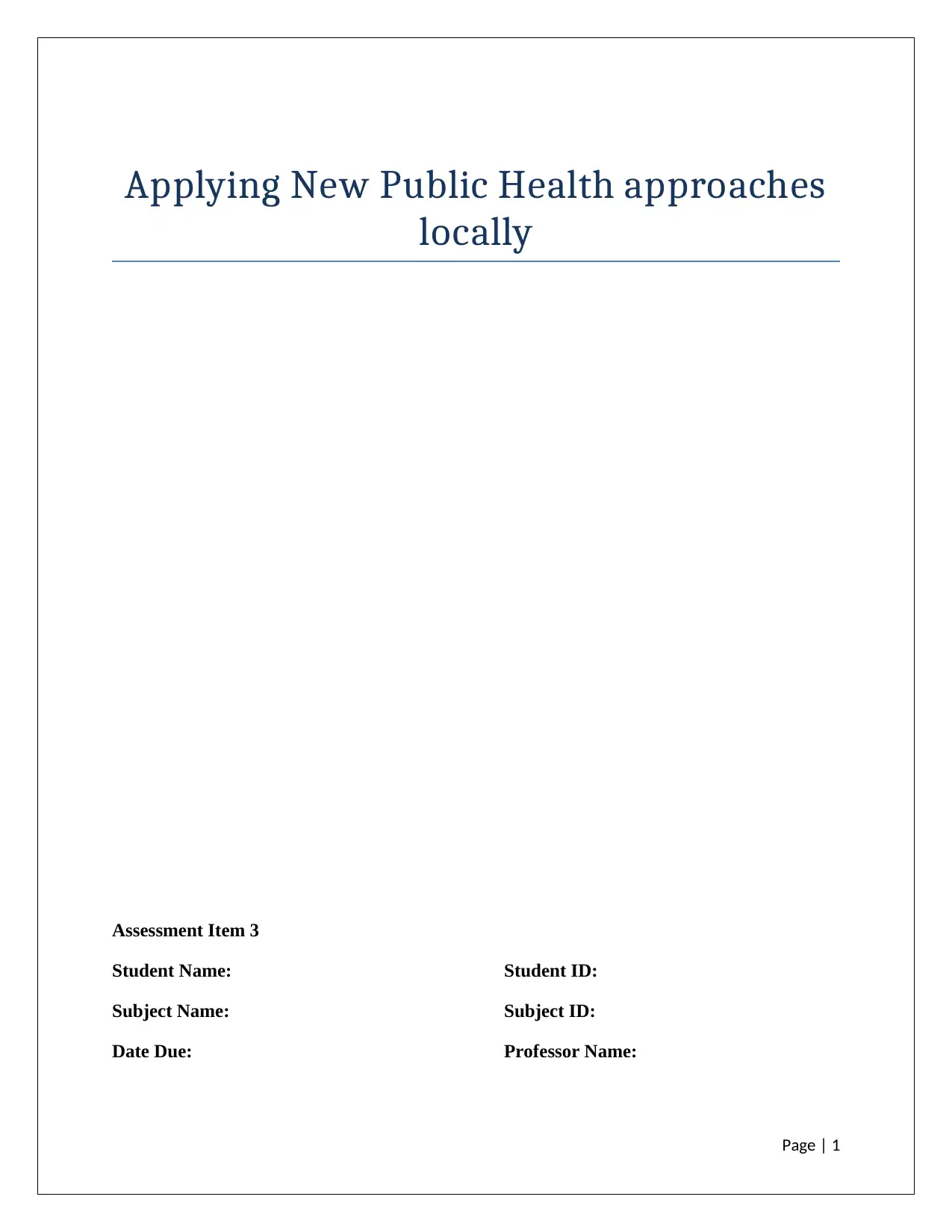
Applying New Public Health approaches
locally
Assessment Item 3
Student Name: Student ID:
Subject Name: Subject ID:
Date Due: Professor Name:
Page | 1
locally
Assessment Item 3
Student Name: Student ID:
Subject Name: Subject ID:
Date Due: Professor Name:
Page | 1
Paraphrase This Document
Need a fresh take? Get an instant paraphrase of this document with our AI Paraphraser
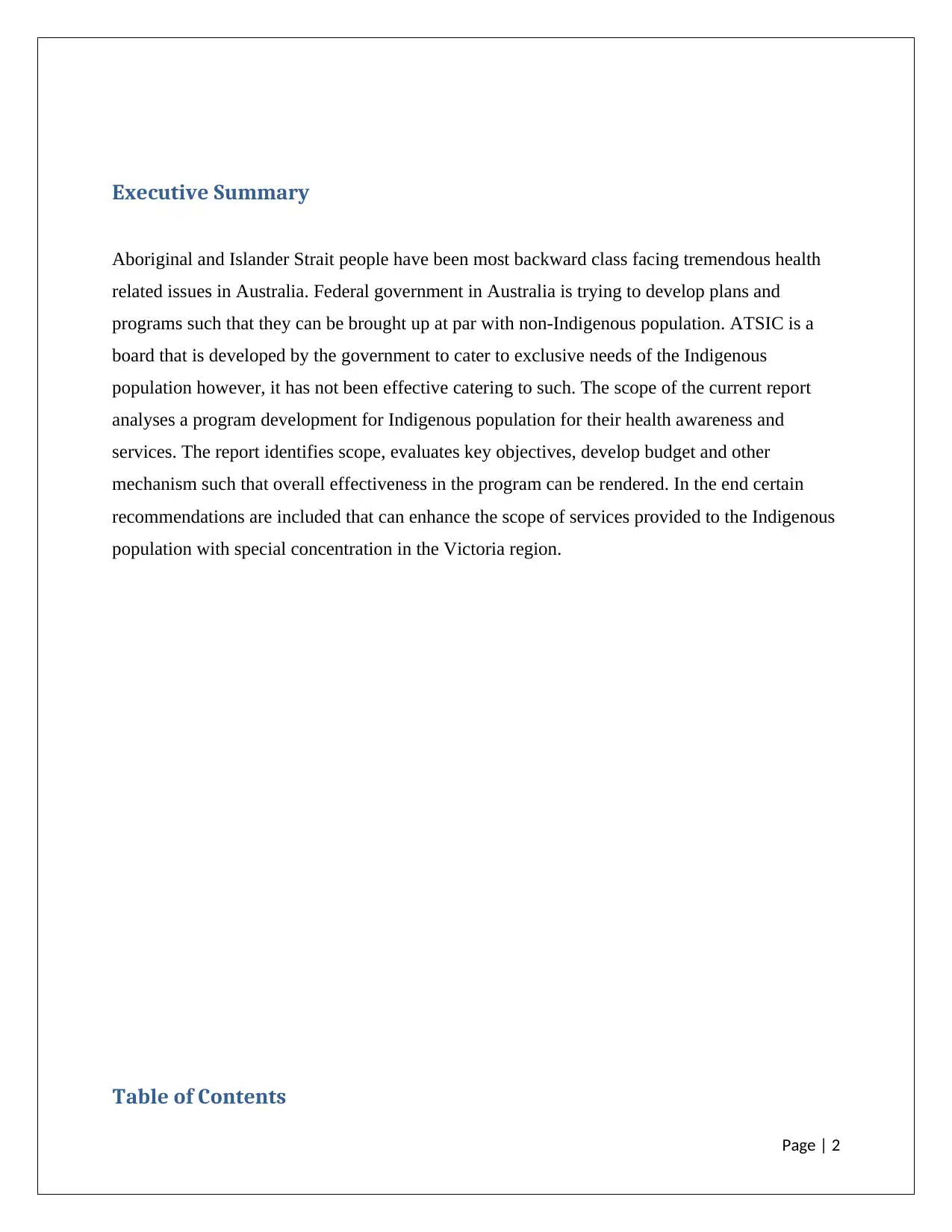
Executive Summary
Aboriginal and Islander Strait people have been most backward class facing tremendous health
related issues in Australia. Federal government in Australia is trying to develop plans and
programs such that they can be brought up at par with non-Indigenous population. ATSIC is a
board that is developed by the government to cater to exclusive needs of the Indigenous
population however, it has not been effective catering to such. The scope of the current report
analyses a program development for Indigenous population for their health awareness and
services. The report identifies scope, evaluates key objectives, develop budget and other
mechanism such that overall effectiveness in the program can be rendered. In the end certain
recommendations are included that can enhance the scope of services provided to the Indigenous
population with special concentration in the Victoria region.
Table of Contents
Page | 2
Aboriginal and Islander Strait people have been most backward class facing tremendous health
related issues in Australia. Federal government in Australia is trying to develop plans and
programs such that they can be brought up at par with non-Indigenous population. ATSIC is a
board that is developed by the government to cater to exclusive needs of the Indigenous
population however, it has not been effective catering to such. The scope of the current report
analyses a program development for Indigenous population for their health awareness and
services. The report identifies scope, evaluates key objectives, develop budget and other
mechanism such that overall effectiveness in the program can be rendered. In the end certain
recommendations are included that can enhance the scope of services provided to the Indigenous
population with special concentration in the Victoria region.
Table of Contents
Page | 2
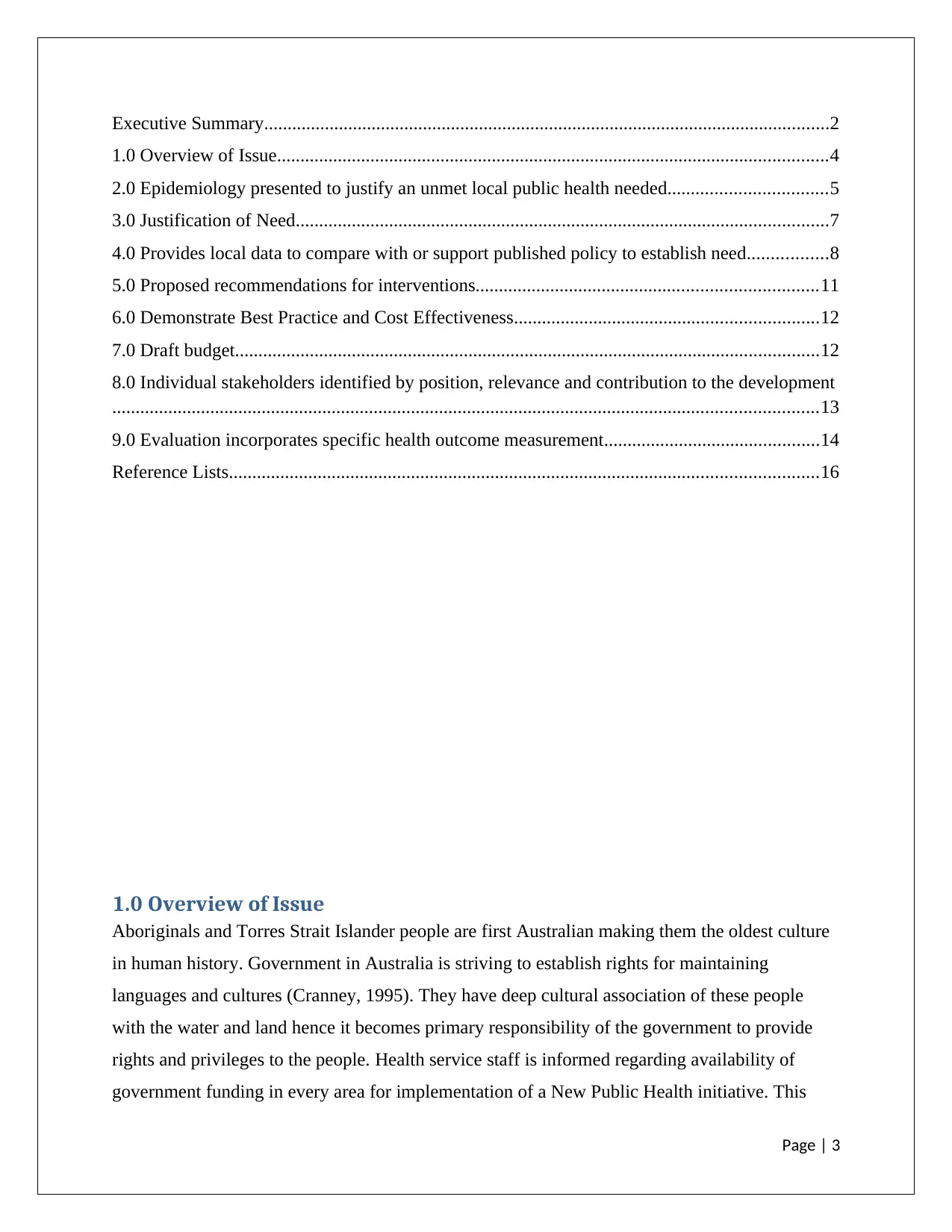
Executive Summary.........................................................................................................................2
1.0 Overview of Issue......................................................................................................................4
2.0 Epidemiology presented to justify an unmet local public health needed..................................5
3.0 Justification of Need..................................................................................................................7
4.0 Provides local data to compare with or support published policy to establish need.................8
5.0 Proposed recommendations for interventions.........................................................................11
6.0 Demonstrate Best Practice and Cost Effectiveness.................................................................12
7.0 Draft budget.............................................................................................................................12
8.0 Individual stakeholders identified by position, relevance and contribution to the development
.......................................................................................................................................................13
9.0 Evaluation incorporates specific health outcome measurement..............................................14
Reference Lists..............................................................................................................................16
1.0 Overview of Issue
Aboriginals and Torres Strait Islander people are first Australian making them the oldest culture
in human history. Government in Australia is striving to establish rights for maintaining
languages and cultures (Cranney, 1995). They have deep cultural association of these people
with the water and land hence it becomes primary responsibility of the government to provide
rights and privileges to the people. Health service staff is informed regarding availability of
government funding in every area for implementation of a New Public Health initiative. This
Page | 3
1.0 Overview of Issue......................................................................................................................4
2.0 Epidemiology presented to justify an unmet local public health needed..................................5
3.0 Justification of Need..................................................................................................................7
4.0 Provides local data to compare with or support published policy to establish need.................8
5.0 Proposed recommendations for interventions.........................................................................11
6.0 Demonstrate Best Practice and Cost Effectiveness.................................................................12
7.0 Draft budget.............................................................................................................................12
8.0 Individual stakeholders identified by position, relevance and contribution to the development
.......................................................................................................................................................13
9.0 Evaluation incorporates specific health outcome measurement..............................................14
Reference Lists..............................................................................................................................16
1.0 Overview of Issue
Aboriginals and Torres Strait Islander people are first Australian making them the oldest culture
in human history. Government in Australia is striving to establish rights for maintaining
languages and cultures (Cranney, 1995). They have deep cultural association of these people
with the water and land hence it becomes primary responsibility of the government to provide
rights and privileges to the people. Health service staff is informed regarding availability of
government funding in every area for implementation of a New Public Health initiative. This
Page | 3
⊘ This is a preview!⊘
Do you want full access?
Subscribe today to unlock all pages.

Trusted by 1+ million students worldwide
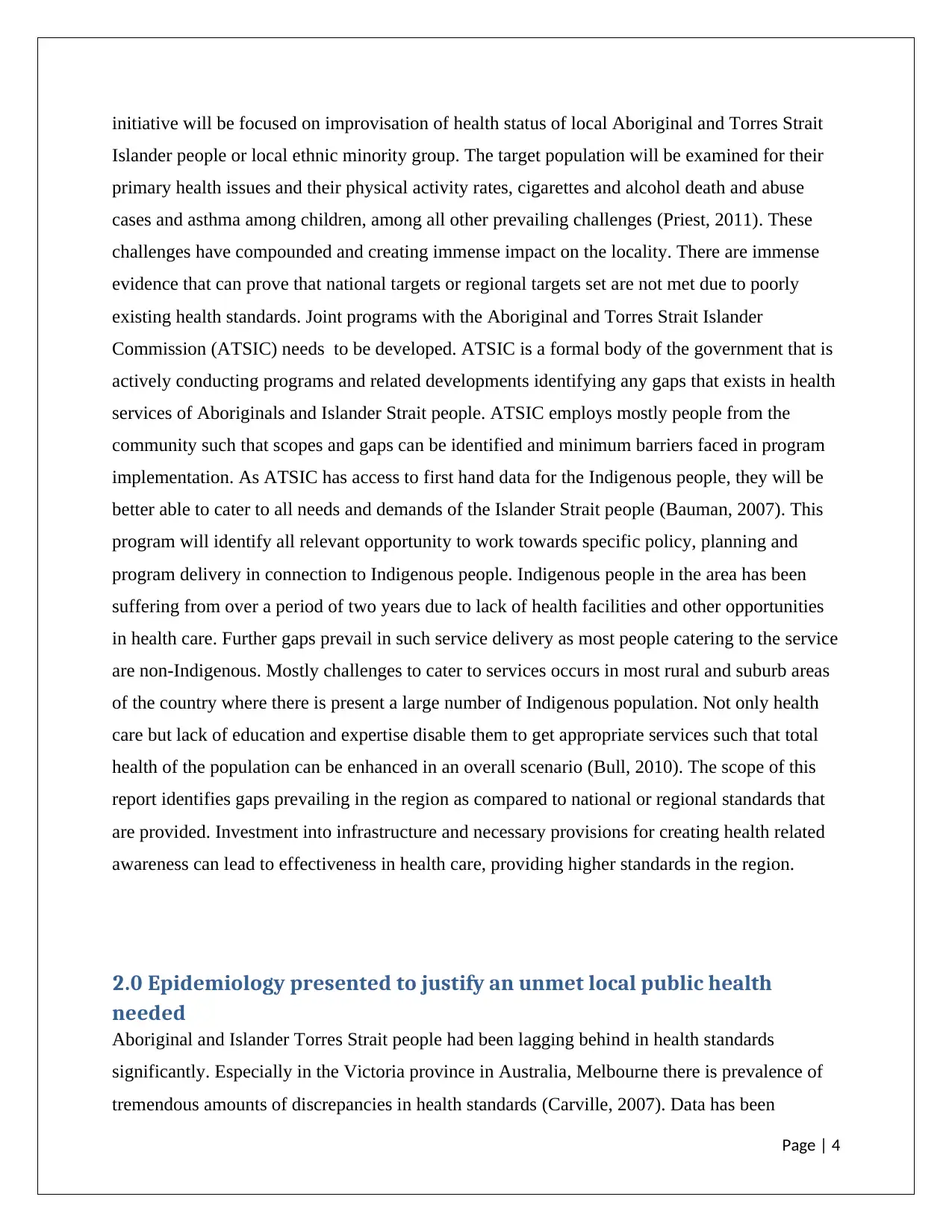
initiative will be focused on improvisation of health status of local Aboriginal and Torres Strait
Islander people or local ethnic minority group. The target population will be examined for their
primary health issues and their physical activity rates, cigarettes and alcohol death and abuse
cases and asthma among children, among all other prevailing challenges (Priest, 2011). These
challenges have compounded and creating immense impact on the locality. There are immense
evidence that can prove that national targets or regional targets set are not met due to poorly
existing health standards. Joint programs with the Aboriginal and Torres Strait Islander
Commission (ATSIC) needs to be developed. ATSIC is a formal body of the government that is
actively conducting programs and related developments identifying any gaps that exists in health
services of Aboriginals and Islander Strait people. ATSIC employs mostly people from the
community such that scopes and gaps can be identified and minimum barriers faced in program
implementation. As ATSIC has access to first hand data for the Indigenous people, they will be
better able to cater to all needs and demands of the Islander Strait people (Bauman, 2007). This
program will identify all relevant opportunity to work towards specific policy, planning and
program delivery in connection to Indigenous people. Indigenous people in the area has been
suffering from over a period of two years due to lack of health facilities and other opportunities
in health care. Further gaps prevail in such service delivery as most people catering to the service
are non-Indigenous. Mostly challenges to cater to services occurs in most rural and suburb areas
of the country where there is present a large number of Indigenous population. Not only health
care but lack of education and expertise disable them to get appropriate services such that total
health of the population can be enhanced in an overall scenario (Bull, 2010). The scope of this
report identifies gaps prevailing in the region as compared to national or regional standards that
are provided. Investment into infrastructure and necessary provisions for creating health related
awareness can lead to effectiveness in health care, providing higher standards in the region.
2.0 Epidemiology presented to justify an unmet local public health
needed
Aboriginal and Islander Torres Strait people had been lagging behind in health standards
significantly. Especially in the Victoria province in Australia, Melbourne there is prevalence of
tremendous amounts of discrepancies in health standards (Carville, 2007). Data has been
Page | 4
Islander people or local ethnic minority group. The target population will be examined for their
primary health issues and their physical activity rates, cigarettes and alcohol death and abuse
cases and asthma among children, among all other prevailing challenges (Priest, 2011). These
challenges have compounded and creating immense impact on the locality. There are immense
evidence that can prove that national targets or regional targets set are not met due to poorly
existing health standards. Joint programs with the Aboriginal and Torres Strait Islander
Commission (ATSIC) needs to be developed. ATSIC is a formal body of the government that is
actively conducting programs and related developments identifying any gaps that exists in health
services of Aboriginals and Islander Strait people. ATSIC employs mostly people from the
community such that scopes and gaps can be identified and minimum barriers faced in program
implementation. As ATSIC has access to first hand data for the Indigenous people, they will be
better able to cater to all needs and demands of the Islander Strait people (Bauman, 2007). This
program will identify all relevant opportunity to work towards specific policy, planning and
program delivery in connection to Indigenous people. Indigenous people in the area has been
suffering from over a period of two years due to lack of health facilities and other opportunities
in health care. Further gaps prevail in such service delivery as most people catering to the service
are non-Indigenous. Mostly challenges to cater to services occurs in most rural and suburb areas
of the country where there is present a large number of Indigenous population. Not only health
care but lack of education and expertise disable them to get appropriate services such that total
health of the population can be enhanced in an overall scenario (Bull, 2010). The scope of this
report identifies gaps prevailing in the region as compared to national or regional standards that
are provided. Investment into infrastructure and necessary provisions for creating health related
awareness can lead to effectiveness in health care, providing higher standards in the region.
2.0 Epidemiology presented to justify an unmet local public health
needed
Aboriginal and Islander Torres Strait people had been lagging behind in health standards
significantly. Especially in the Victoria province in Australia, Melbourne there is prevalence of
tremendous amounts of discrepancies in health standards (Carville, 2007). Data has been
Page | 4
Paraphrase This Document
Need a fresh take? Get an instant paraphrase of this document with our AI Paraphraser
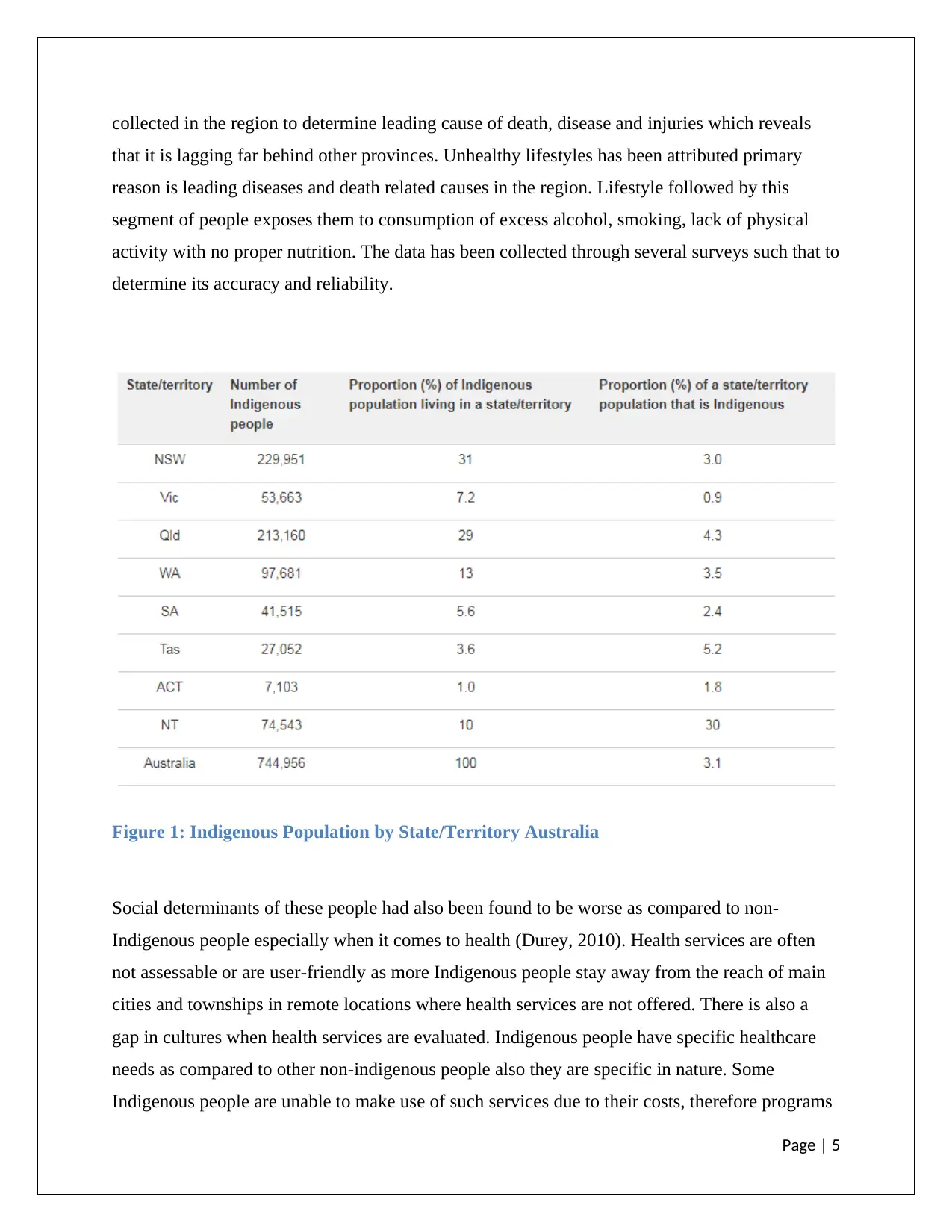
collected in the region to determine leading cause of death, disease and injuries which reveals
that it is lagging far behind other provinces. Unhealthy lifestyles has been attributed primary
reason is leading diseases and death related causes in the region. Lifestyle followed by this
segment of people exposes them to consumption of excess alcohol, smoking, lack of physical
activity with no proper nutrition. The data has been collected through several surveys such that to
determine its accuracy and reliability.
Figure 1: Indigenous Population by State/Territory Australia
Social determinants of these people had also been found to be worse as compared to non-
Indigenous people especially when it comes to health (Durey, 2010). Health services are often
not assessable or are user-friendly as more Indigenous people stay away from the reach of main
cities and townships in remote locations where health services are not offered. There is also a
gap in cultures when health services are evaluated. Indigenous people have specific healthcare
needs as compared to other non-indigenous people also they are specific in nature. Some
Indigenous people are unable to make use of such services due to their costs, therefore programs
Page | 5
that it is lagging far behind other provinces. Unhealthy lifestyles has been attributed primary
reason is leading diseases and death related causes in the region. Lifestyle followed by this
segment of people exposes them to consumption of excess alcohol, smoking, lack of physical
activity with no proper nutrition. The data has been collected through several surveys such that to
determine its accuracy and reliability.
Figure 1: Indigenous Population by State/Territory Australia
Social determinants of these people had also been found to be worse as compared to non-
Indigenous people especially when it comes to health (Durey, 2010). Health services are often
not assessable or are user-friendly as more Indigenous people stay away from the reach of main
cities and townships in remote locations where health services are not offered. There is also a
gap in cultures when health services are evaluated. Indigenous people have specific healthcare
needs as compared to other non-indigenous people also they are specific in nature. Some
Indigenous people are unable to make use of such services due to their costs, therefore programs
Page | 5
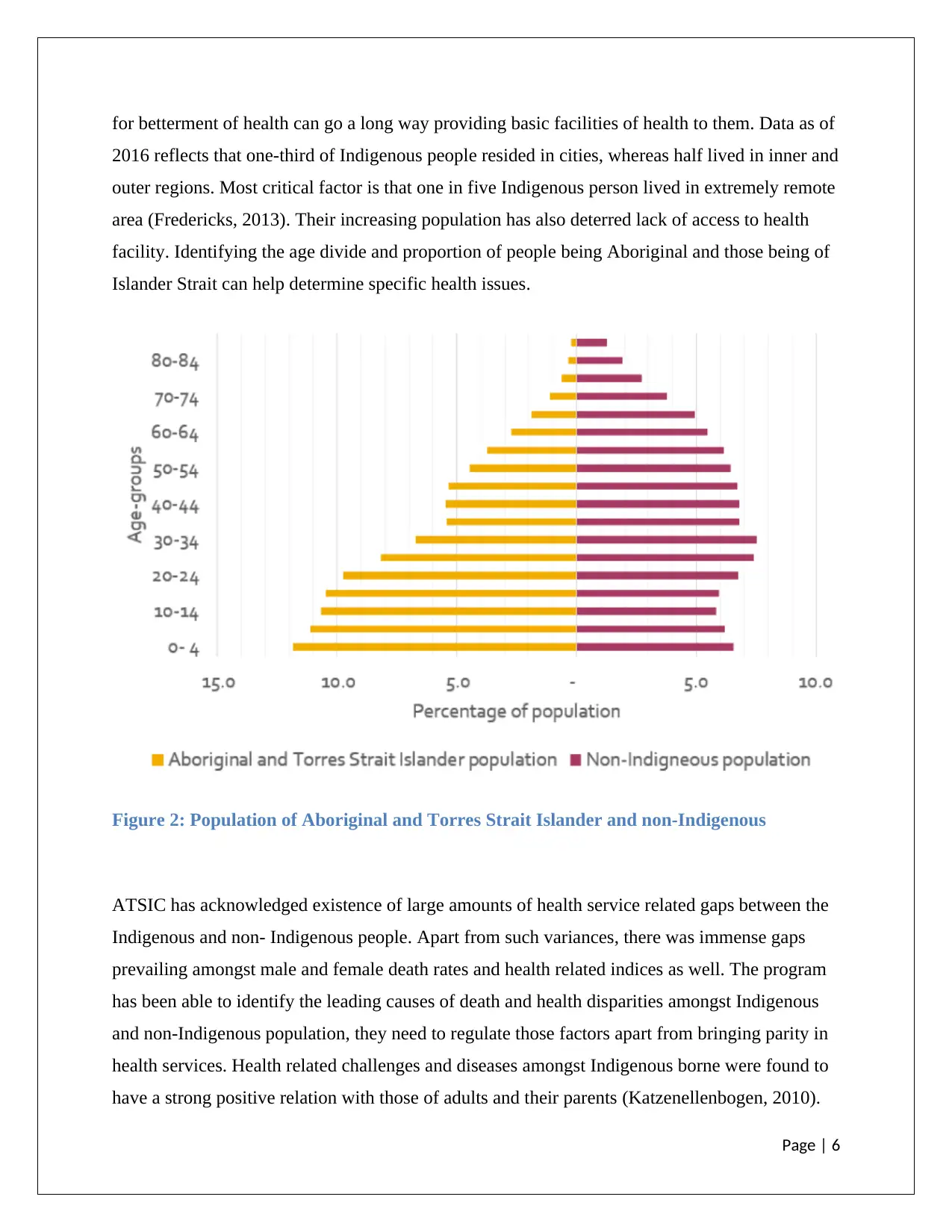
for betterment of health can go a long way providing basic facilities of health to them. Data as of
2016 reflects that one-third of Indigenous people resided in cities, whereas half lived in inner and
outer regions. Most critical factor is that one in five Indigenous person lived in extremely remote
area (Fredericks, 2013). Their increasing population has also deterred lack of access to health
facility. Identifying the age divide and proportion of people being Aboriginal and those being of
Islander Strait can help determine specific health issues.
Figure 2: Population of Aboriginal and Torres Strait Islander and non-Indigenous
ATSIC has acknowledged existence of large amounts of health service related gaps between the
Indigenous and non- Indigenous people. Apart from such variances, there was immense gaps
prevailing amongst male and female death rates and health related indices as well. The program
has been able to identify the leading causes of death and health disparities amongst Indigenous
and non-Indigenous population, they need to regulate those factors apart from bringing parity in
health services. Health related challenges and diseases amongst Indigenous borne were found to
have a strong positive relation with those of adults and their parents (Katzenellenbogen, 2010).
Page | 6
2016 reflects that one-third of Indigenous people resided in cities, whereas half lived in inner and
outer regions. Most critical factor is that one in five Indigenous person lived in extremely remote
area (Fredericks, 2013). Their increasing population has also deterred lack of access to health
facility. Identifying the age divide and proportion of people being Aboriginal and those being of
Islander Strait can help determine specific health issues.
Figure 2: Population of Aboriginal and Torres Strait Islander and non-Indigenous
ATSIC has acknowledged existence of large amounts of health service related gaps between the
Indigenous and non- Indigenous people. Apart from such variances, there was immense gaps
prevailing amongst male and female death rates and health related indices as well. The program
has been able to identify the leading causes of death and health disparities amongst Indigenous
and non-Indigenous population, they need to regulate those factors apart from bringing parity in
health services. Health related challenges and diseases amongst Indigenous borne were found to
have a strong positive relation with those of adults and their parents (Katzenellenbogen, 2010).
Page | 6
⊘ This is a preview!⊘
Do you want full access?
Subscribe today to unlock all pages.

Trusted by 1+ million students worldwide
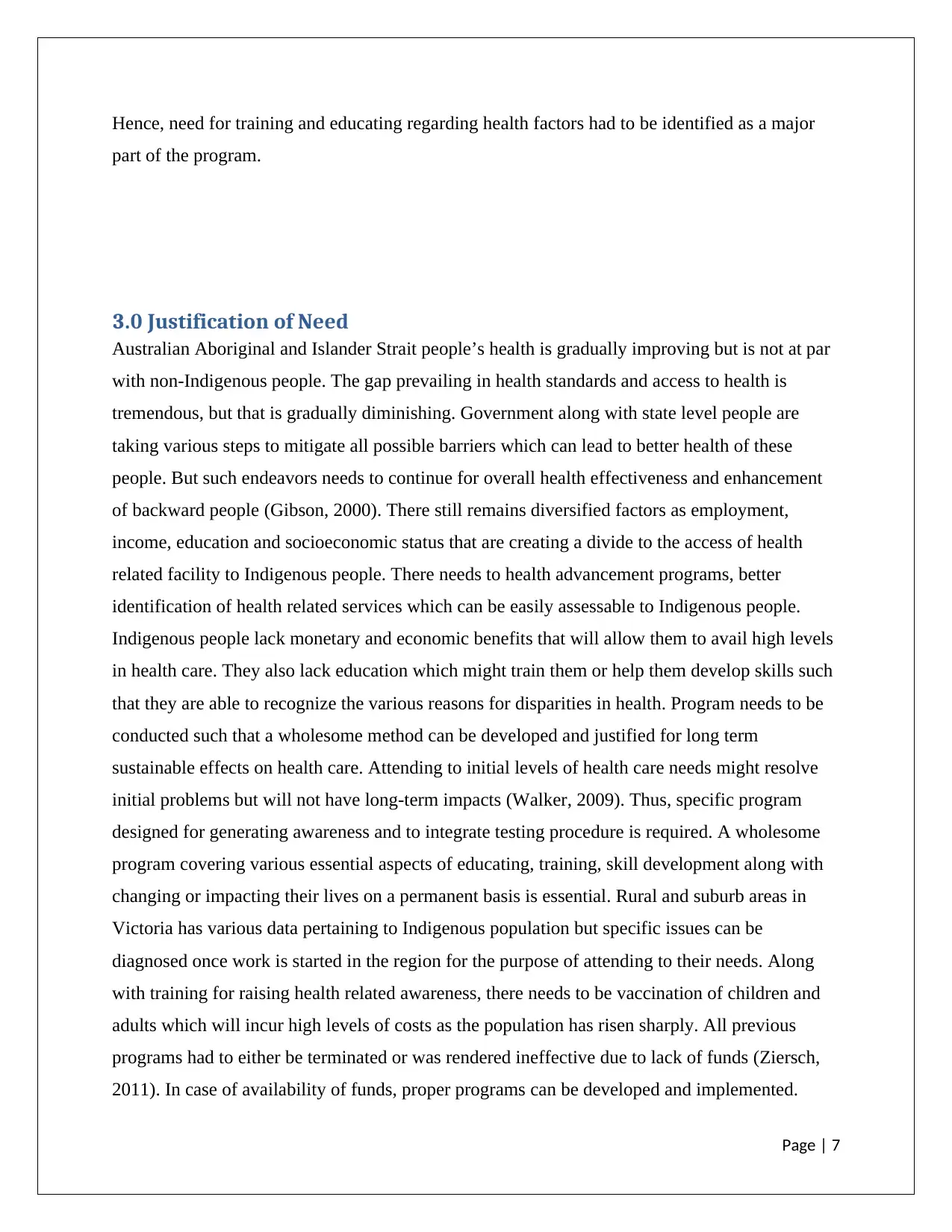
Hence, need for training and educating regarding health factors had to be identified as a major
part of the program.
3.0 Justification of Need
Australian Aboriginal and Islander Strait people’s health is gradually improving but is not at par
with non-Indigenous people. The gap prevailing in health standards and access to health is
tremendous, but that is gradually diminishing. Government along with state level people are
taking various steps to mitigate all possible barriers which can lead to better health of these
people. But such endeavors needs to continue for overall health effectiveness and enhancement
of backward people (Gibson, 2000). There still remains diversified factors as employment,
income, education and socioeconomic status that are creating a divide to the access of health
related facility to Indigenous people. There needs to health advancement programs, better
identification of health related services which can be easily assessable to Indigenous people.
Indigenous people lack monetary and economic benefits that will allow them to avail high levels
in health care. They also lack education which might train them or help them develop skills such
that they are able to recognize the various reasons for disparities in health. Program needs to be
conducted such that a wholesome method can be developed and justified for long term
sustainable effects on health care. Attending to initial levels of health care needs might resolve
initial problems but will not have long-term impacts (Walker, 2009). Thus, specific program
designed for generating awareness and to integrate testing procedure is required. A wholesome
program covering various essential aspects of educating, training, skill development along with
changing or impacting their lives on a permanent basis is essential. Rural and suburb areas in
Victoria has various data pertaining to Indigenous population but specific issues can be
diagnosed once work is started in the region for the purpose of attending to their needs. Along
with training for raising health related awareness, there needs to be vaccination of children and
adults which will incur high levels of costs as the population has risen sharply. All previous
programs had to either be terminated or was rendered ineffective due to lack of funds (Ziersch,
2011). In case of availability of funds, proper programs can be developed and implemented.
Page | 7
part of the program.
3.0 Justification of Need
Australian Aboriginal and Islander Strait people’s health is gradually improving but is not at par
with non-Indigenous people. The gap prevailing in health standards and access to health is
tremendous, but that is gradually diminishing. Government along with state level people are
taking various steps to mitigate all possible barriers which can lead to better health of these
people. But such endeavors needs to continue for overall health effectiveness and enhancement
of backward people (Gibson, 2000). There still remains diversified factors as employment,
income, education and socioeconomic status that are creating a divide to the access of health
related facility to Indigenous people. There needs to health advancement programs, better
identification of health related services which can be easily assessable to Indigenous people.
Indigenous people lack monetary and economic benefits that will allow them to avail high levels
in health care. They also lack education which might train them or help them develop skills such
that they are able to recognize the various reasons for disparities in health. Program needs to be
conducted such that a wholesome method can be developed and justified for long term
sustainable effects on health care. Attending to initial levels of health care needs might resolve
initial problems but will not have long-term impacts (Walker, 2009). Thus, specific program
designed for generating awareness and to integrate testing procedure is required. A wholesome
program covering various essential aspects of educating, training, skill development along with
changing or impacting their lives on a permanent basis is essential. Rural and suburb areas in
Victoria has various data pertaining to Indigenous population but specific issues can be
diagnosed once work is started in the region for the purpose of attending to their needs. Along
with training for raising health related awareness, there needs to be vaccination of children and
adults which will incur high levels of costs as the population has risen sharply. All previous
programs had to either be terminated or was rendered ineffective due to lack of funds (Ziersch,
2011). In case of availability of funds, proper programs can be developed and implemented.
Page | 7
Paraphrase This Document
Need a fresh take? Get an instant paraphrase of this document with our AI Paraphraser
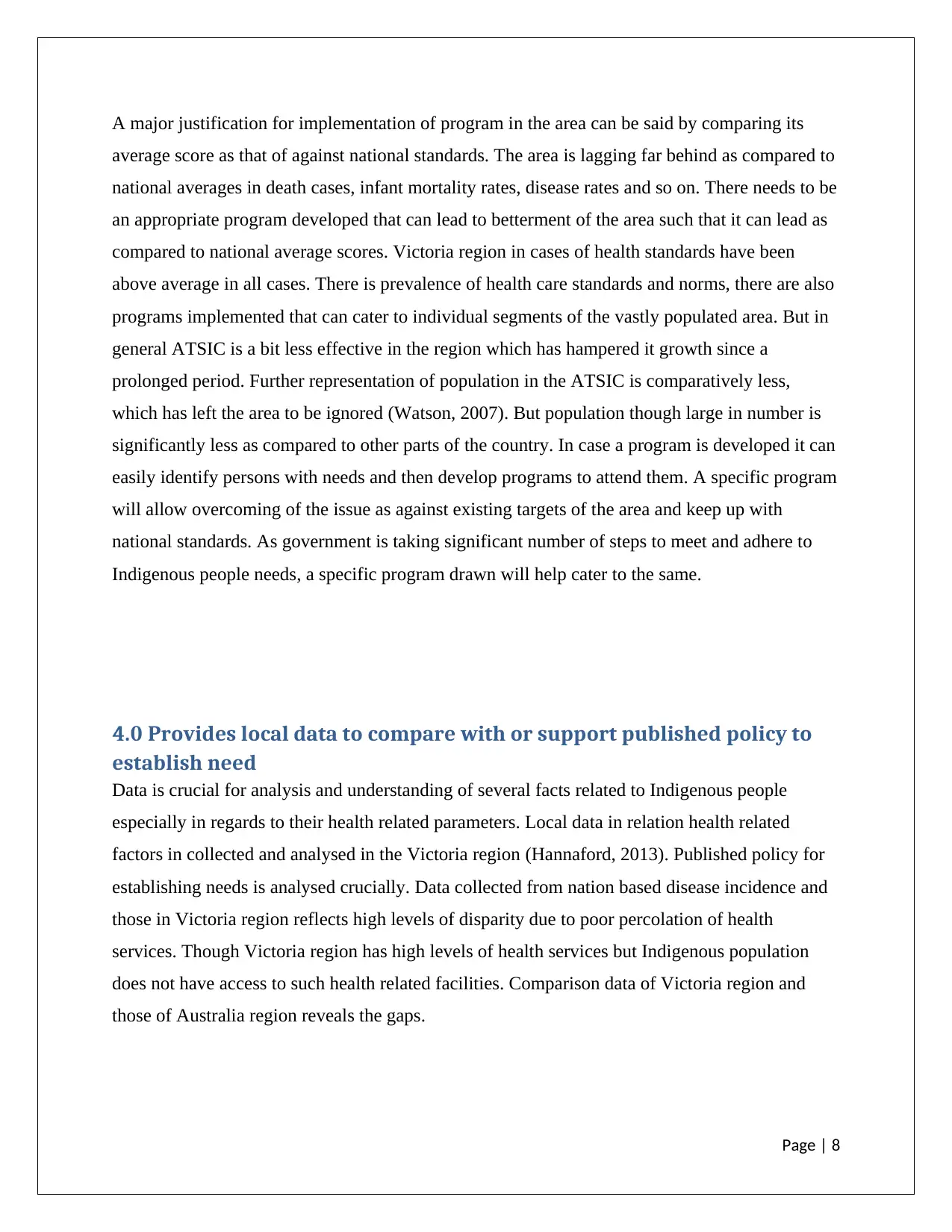
A major justification for implementation of program in the area can be said by comparing its
average score as that of against national standards. The area is lagging far behind as compared to
national averages in death cases, infant mortality rates, disease rates and so on. There needs to be
an appropriate program developed that can lead to betterment of the area such that it can lead as
compared to national average scores. Victoria region in cases of health standards have been
above average in all cases. There is prevalence of health care standards and norms, there are also
programs implemented that can cater to individual segments of the vastly populated area. But in
general ATSIC is a bit less effective in the region which has hampered it growth since a
prolonged period. Further representation of population in the ATSIC is comparatively less,
which has left the area to be ignored (Watson, 2007). But population though large in number is
significantly less as compared to other parts of the country. In case a program is developed it can
easily identify persons with needs and then develop programs to attend them. A specific program
will allow overcoming of the issue as against existing targets of the area and keep up with
national standards. As government is taking significant number of steps to meet and adhere to
Indigenous people needs, a specific program drawn will help cater to the same.
4.0 Provides local data to compare with or support published policy to
establish need
Data is crucial for analysis and understanding of several facts related to Indigenous people
especially in regards to their health related parameters. Local data in relation health related
factors in collected and analysed in the Victoria region (Hannaford, 2013). Published policy for
establishing needs is analysed crucially. Data collected from nation based disease incidence and
those in Victoria region reflects high levels of disparity due to poor percolation of health
services. Though Victoria region has high levels of health services but Indigenous population
does not have access to such health related facilities. Comparison data of Victoria region and
those of Australia region reveals the gaps.
Page | 8
average score as that of against national standards. The area is lagging far behind as compared to
national averages in death cases, infant mortality rates, disease rates and so on. There needs to be
an appropriate program developed that can lead to betterment of the area such that it can lead as
compared to national average scores. Victoria region in cases of health standards have been
above average in all cases. There is prevalence of health care standards and norms, there are also
programs implemented that can cater to individual segments of the vastly populated area. But in
general ATSIC is a bit less effective in the region which has hampered it growth since a
prolonged period. Further representation of population in the ATSIC is comparatively less,
which has left the area to be ignored (Watson, 2007). But population though large in number is
significantly less as compared to other parts of the country. In case a program is developed it can
easily identify persons with needs and then develop programs to attend them. A specific program
will allow overcoming of the issue as against existing targets of the area and keep up with
national standards. As government is taking significant number of steps to meet and adhere to
Indigenous people needs, a specific program drawn will help cater to the same.
4.0 Provides local data to compare with or support published policy to
establish need
Data is crucial for analysis and understanding of several facts related to Indigenous people
especially in regards to their health related parameters. Local data in relation health related
factors in collected and analysed in the Victoria region (Hannaford, 2013). Published policy for
establishing needs is analysed crucially. Data collected from nation based disease incidence and
those in Victoria region reflects high levels of disparity due to poor percolation of health
services. Though Victoria region has high levels of health services but Indigenous population
does not have access to such health related facilities. Comparison data of Victoria region and
those of Australia region reveals the gaps.
Page | 8
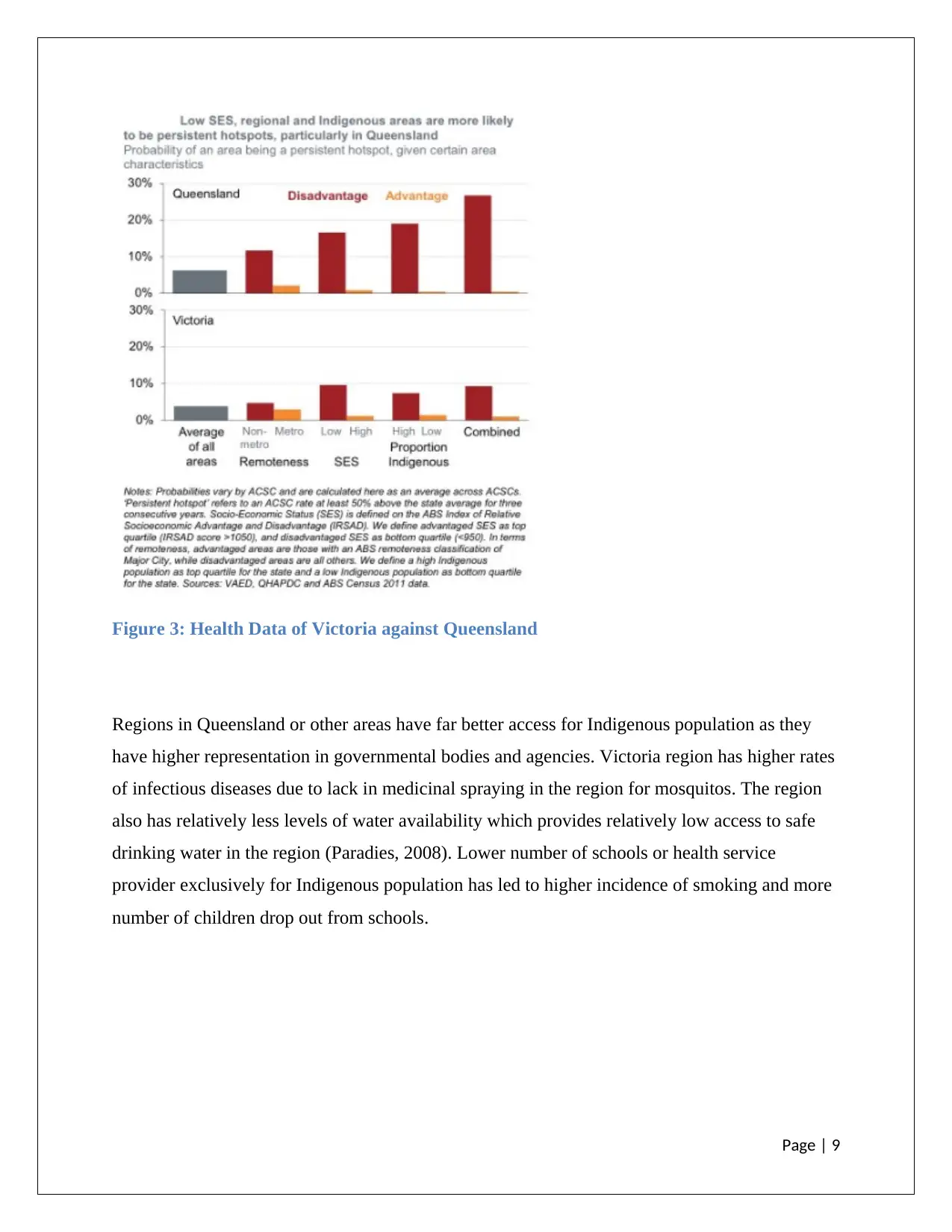
Figure 3: Health Data of Victoria against Queensland
Regions in Queensland or other areas have far better access for Indigenous population as they
have higher representation in governmental bodies and agencies. Victoria region has higher rates
of infectious diseases due to lack in medicinal spraying in the region for mosquitos. The region
also has relatively less levels of water availability which provides relatively low access to safe
drinking water in the region (Paradies, 2008). Lower number of schools or health service
provider exclusively for Indigenous population has led to higher incidence of smoking and more
number of children drop out from schools.
Page | 9
Regions in Queensland or other areas have far better access for Indigenous population as they
have higher representation in governmental bodies and agencies. Victoria region has higher rates
of infectious diseases due to lack in medicinal spraying in the region for mosquitos. The region
also has relatively less levels of water availability which provides relatively low access to safe
drinking water in the region (Paradies, 2008). Lower number of schools or health service
provider exclusively for Indigenous population has led to higher incidence of smoking and more
number of children drop out from schools.
Page | 9
⊘ This is a preview!⊘
Do you want full access?
Subscribe today to unlock all pages.

Trusted by 1+ million students worldwide
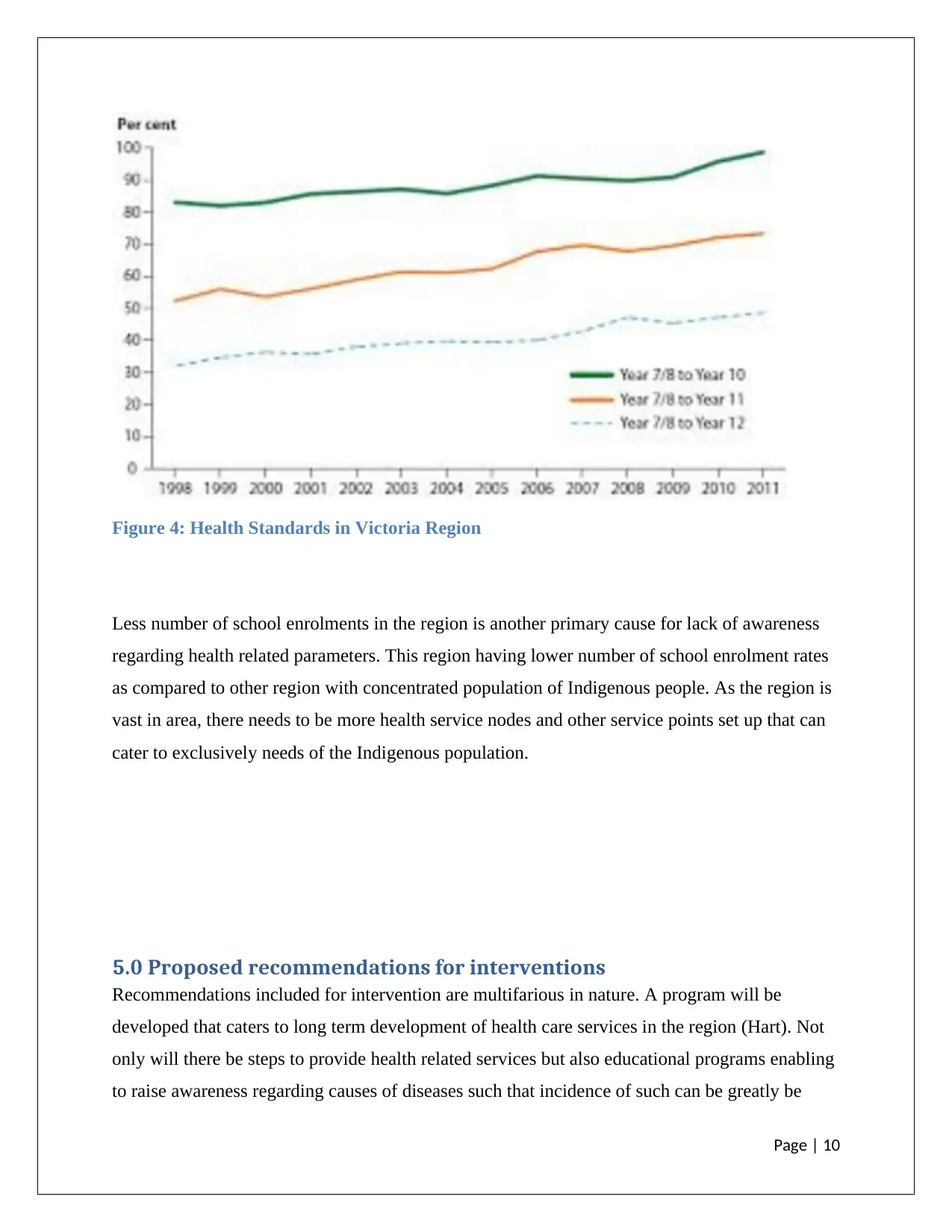
Figure 4: Health Standards in Victoria Region
Less number of school enrolments in the region is another primary cause for lack of awareness
regarding health related parameters. This region having lower number of school enrolment rates
as compared to other region with concentrated population of Indigenous people. As the region is
vast in area, there needs to be more health service nodes and other service points set up that can
cater to exclusively needs of the Indigenous population.
5.0 Proposed recommendations for interventions
Recommendations included for intervention are multifarious in nature. A program will be
developed that caters to long term development of health care services in the region (Hart). Not
only will there be steps to provide health related services but also educational programs enabling
to raise awareness regarding causes of diseases such that incidence of such can be greatly be
Page | 10
Less number of school enrolments in the region is another primary cause for lack of awareness
regarding health related parameters. This region having lower number of school enrolment rates
as compared to other region with concentrated population of Indigenous people. As the region is
vast in area, there needs to be more health service nodes and other service points set up that can
cater to exclusively needs of the Indigenous population.
5.0 Proposed recommendations for interventions
Recommendations included for intervention are multifarious in nature. A program will be
developed that caters to long term development of health care services in the region (Hart). Not
only will there be steps to provide health related services but also educational programs enabling
to raise awareness regarding causes of diseases such that incidence of such can be greatly be
Page | 10
Paraphrase This Document
Need a fresh take? Get an instant paraphrase of this document with our AI Paraphraser
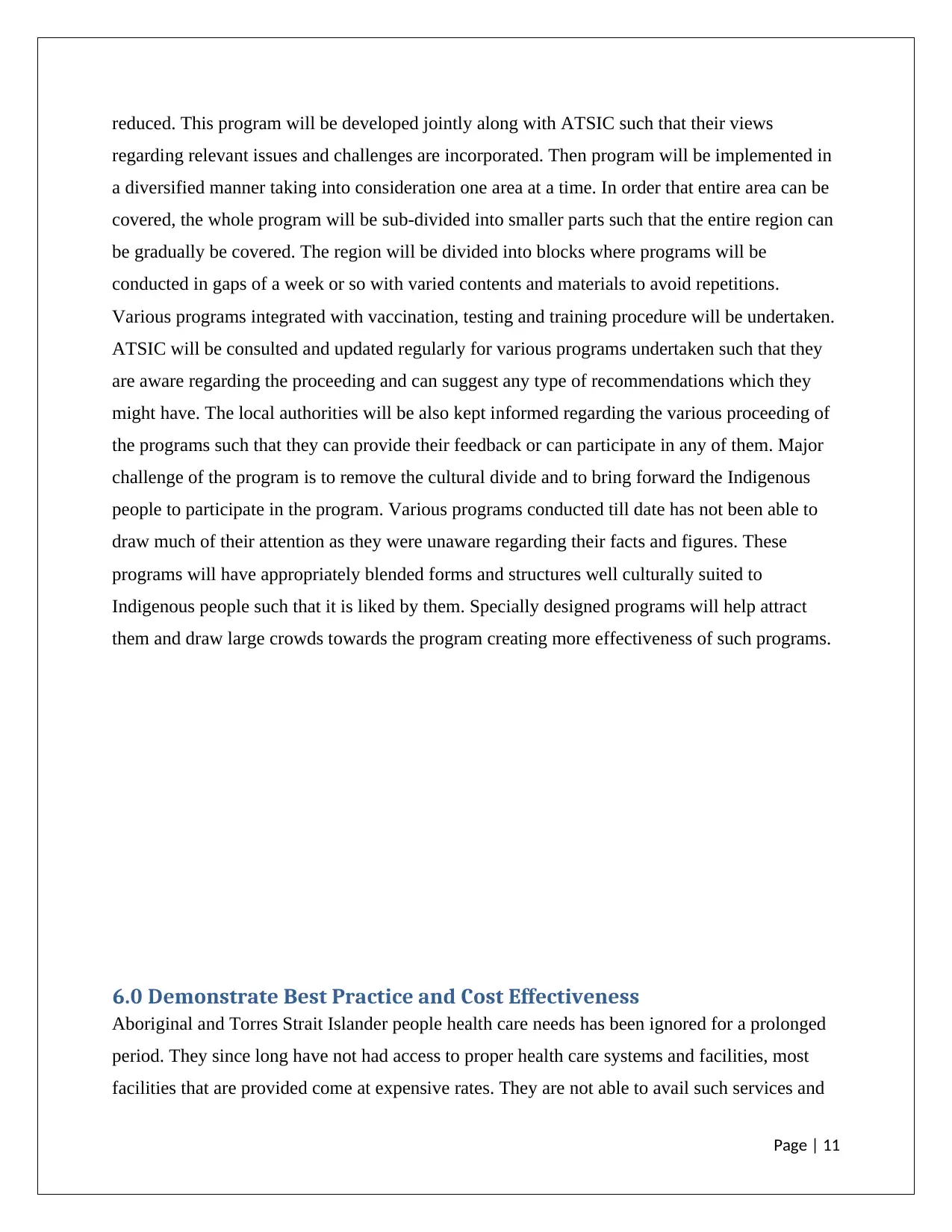
reduced. This program will be developed jointly along with ATSIC such that their views
regarding relevant issues and challenges are incorporated. Then program will be implemented in
a diversified manner taking into consideration one area at a time. In order that entire area can be
covered, the whole program will be sub-divided into smaller parts such that the entire region can
be gradually be covered. The region will be divided into blocks where programs will be
conducted in gaps of a week or so with varied contents and materials to avoid repetitions.
Various programs integrated with vaccination, testing and training procedure will be undertaken.
ATSIC will be consulted and updated regularly for various programs undertaken such that they
are aware regarding the proceeding and can suggest any type of recommendations which they
might have. The local authorities will be also kept informed regarding the various proceeding of
the programs such that they can provide their feedback or can participate in any of them. Major
challenge of the program is to remove the cultural divide and to bring forward the Indigenous
people to participate in the program. Various programs conducted till date has not been able to
draw much of their attention as they were unaware regarding their facts and figures. These
programs will have appropriately blended forms and structures well culturally suited to
Indigenous people such that it is liked by them. Specially designed programs will help attract
them and draw large crowds towards the program creating more effectiveness of such programs.
6.0 Demonstrate Best Practice and Cost Effectiveness
Aboriginal and Torres Strait Islander people health care needs has been ignored for a prolonged
period. They since long have not had access to proper health care systems and facilities, most
facilities that are provided come at expensive rates. They are not able to avail such services and
Page | 11
regarding relevant issues and challenges are incorporated. Then program will be implemented in
a diversified manner taking into consideration one area at a time. In order that entire area can be
covered, the whole program will be sub-divided into smaller parts such that the entire region can
be gradually be covered. The region will be divided into blocks where programs will be
conducted in gaps of a week or so with varied contents and materials to avoid repetitions.
Various programs integrated with vaccination, testing and training procedure will be undertaken.
ATSIC will be consulted and updated regularly for various programs undertaken such that they
are aware regarding the proceeding and can suggest any type of recommendations which they
might have. The local authorities will be also kept informed regarding the various proceeding of
the programs such that they can provide their feedback or can participate in any of them. Major
challenge of the program is to remove the cultural divide and to bring forward the Indigenous
people to participate in the program. Various programs conducted till date has not been able to
draw much of their attention as they were unaware regarding their facts and figures. These
programs will have appropriately blended forms and structures well culturally suited to
Indigenous people such that it is liked by them. Specially designed programs will help attract
them and draw large crowds towards the program creating more effectiveness of such programs.
6.0 Demonstrate Best Practice and Cost Effectiveness
Aboriginal and Torres Strait Islander people health care needs has been ignored for a prolonged
period. They since long have not had access to proper health care systems and facilities, most
facilities that are provided come at expensive rates. They are not able to avail such services and
Page | 11
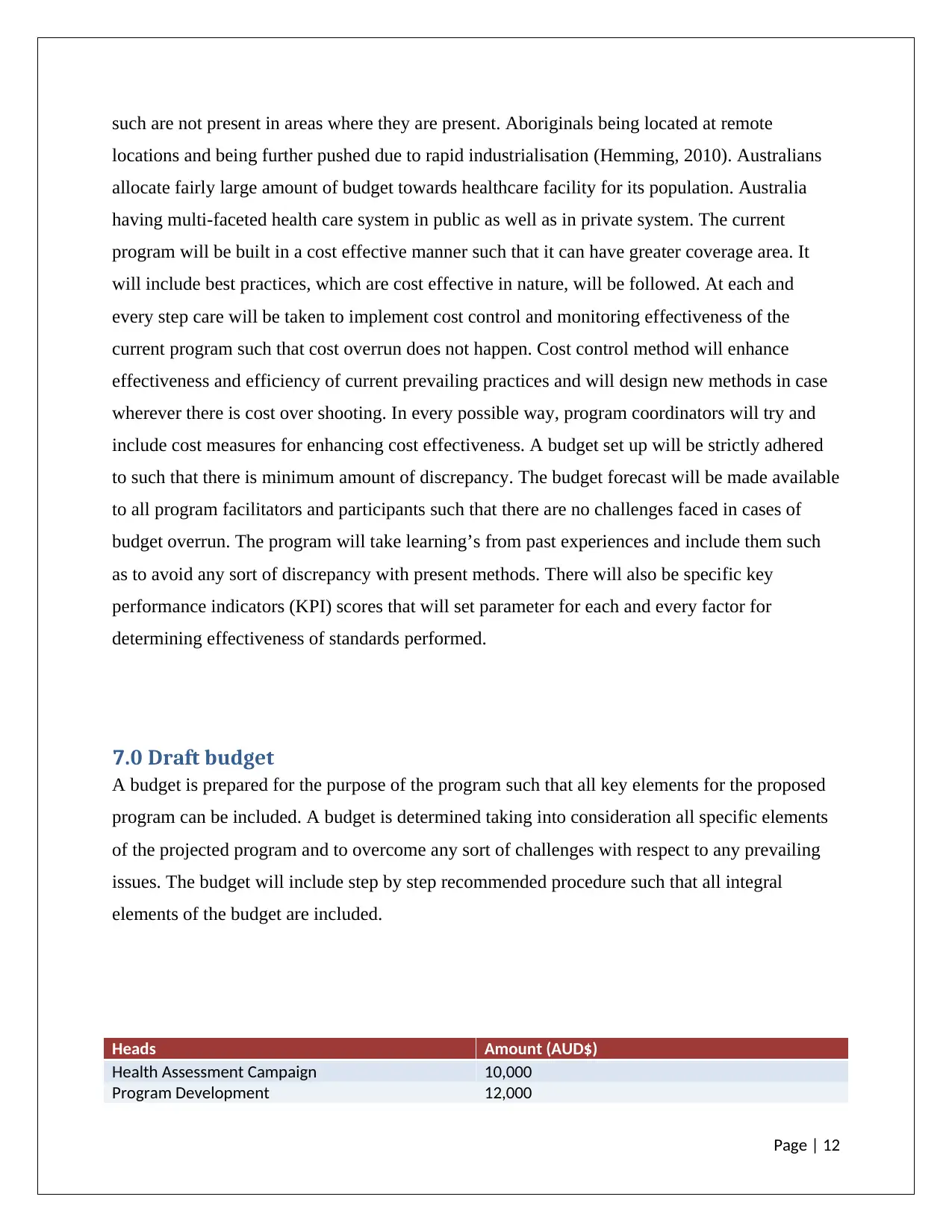
such are not present in areas where they are present. Aboriginals being located at remote
locations and being further pushed due to rapid industrialisation (Hemming, 2010). Australians
allocate fairly large amount of budget towards healthcare facility for its population. Australia
having multi-faceted health care system in public as well as in private system. The current
program will be built in a cost effective manner such that it can have greater coverage area. It
will include best practices, which are cost effective in nature, will be followed. At each and
every step care will be taken to implement cost control and monitoring effectiveness of the
current program such that cost overrun does not happen. Cost control method will enhance
effectiveness and efficiency of current prevailing practices and will design new methods in case
wherever there is cost over shooting. In every possible way, program coordinators will try and
include cost measures for enhancing cost effectiveness. A budget set up will be strictly adhered
to such that there is minimum amount of discrepancy. The budget forecast will be made available
to all program facilitators and participants such that there are no challenges faced in cases of
budget overrun. The program will take learning’s from past experiences and include them such
as to avoid any sort of discrepancy with present methods. There will also be specific key
performance indicators (KPI) scores that will set parameter for each and every factor for
determining effectiveness of standards performed.
7.0 Draft budget
A budget is prepared for the purpose of the program such that all key elements for the proposed
program can be included. A budget is determined taking into consideration all specific elements
of the projected program and to overcome any sort of challenges with respect to any prevailing
issues. The budget will include step by step recommended procedure such that all integral
elements of the budget are included.
Heads Amount (AUD$)
Health Assessment Campaign 10,000
Program Development 12,000
Page | 12
locations and being further pushed due to rapid industrialisation (Hemming, 2010). Australians
allocate fairly large amount of budget towards healthcare facility for its population. Australia
having multi-faceted health care system in public as well as in private system. The current
program will be built in a cost effective manner such that it can have greater coverage area. It
will include best practices, which are cost effective in nature, will be followed. At each and
every step care will be taken to implement cost control and monitoring effectiveness of the
current program such that cost overrun does not happen. Cost control method will enhance
effectiveness and efficiency of current prevailing practices and will design new methods in case
wherever there is cost over shooting. In every possible way, program coordinators will try and
include cost measures for enhancing cost effectiveness. A budget set up will be strictly adhered
to such that there is minimum amount of discrepancy. The budget forecast will be made available
to all program facilitators and participants such that there are no challenges faced in cases of
budget overrun. The program will take learning’s from past experiences and include them such
as to avoid any sort of discrepancy with present methods. There will also be specific key
performance indicators (KPI) scores that will set parameter for each and every factor for
determining effectiveness of standards performed.
7.0 Draft budget
A budget is prepared for the purpose of the program such that all key elements for the proposed
program can be included. A budget is determined taking into consideration all specific elements
of the projected program and to overcome any sort of challenges with respect to any prevailing
issues. The budget will include step by step recommended procedure such that all integral
elements of the budget are included.
Heads Amount (AUD$)
Health Assessment Campaign 10,000
Program Development 12,000
Page | 12
⊘ This is a preview!⊘
Do you want full access?
Subscribe today to unlock all pages.

Trusted by 1+ million students worldwide
1 out of 18
Related Documents
Your All-in-One AI-Powered Toolkit for Academic Success.
+13062052269
info@desklib.com
Available 24*7 on WhatsApp / Email
![[object Object]](/_next/static/media/star-bottom.7253800d.svg)
Unlock your academic potential
Copyright © 2020–2025 A2Z Services. All Rights Reserved. Developed and managed by ZUCOL.




